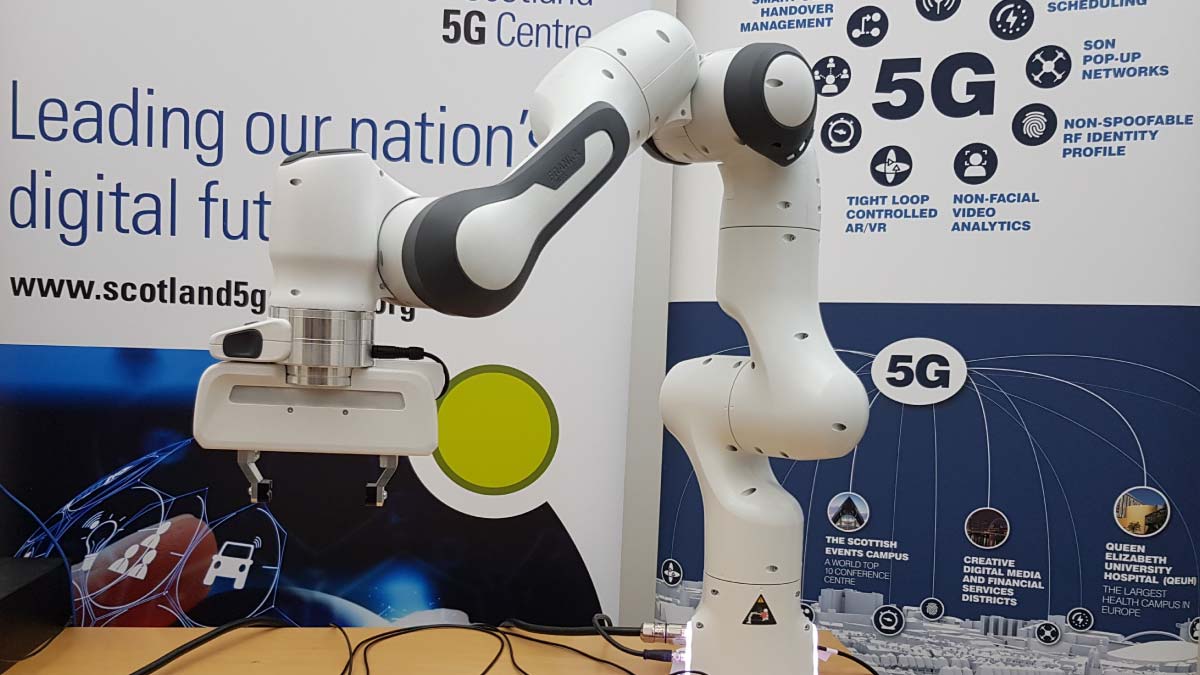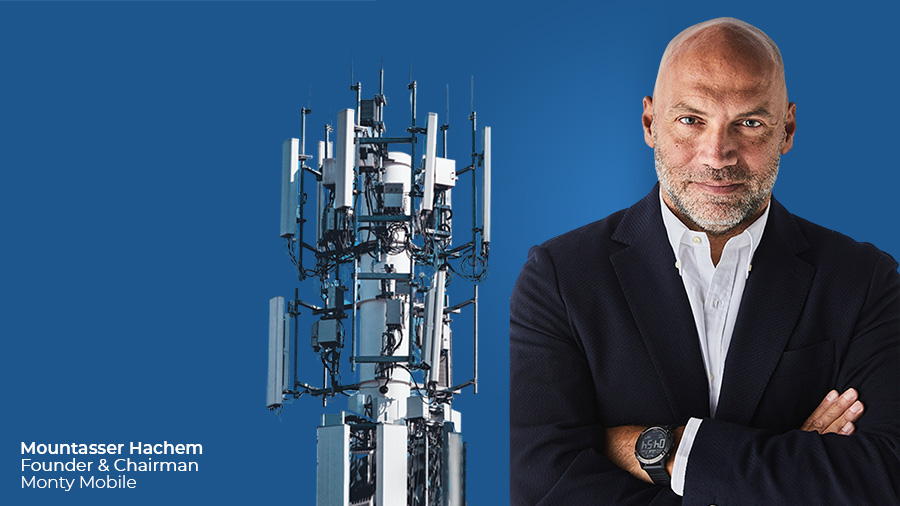Press Releases
5G enables university students to carry out remote lab work using pioneering remote robotics

• Huge potential for commercial applications across manufacturing, healthcare and other industries that are normally reliant on physical human intervention
• Testbed mobile network funded by £1.6m from The Scotland 5G Centre
• One of the first demonstration of remote robotics in higher education
Scotland is making substantial progress in developing much-needed applications using 5G technology, according to the chief executive of the Scotland 5G Centre.
Launched one year ago, and funded by the Scottish Government, the Centre is working at a national level to stimulate economic development and promote the benefits to society of 5G connectivity.
One project that has already been thoroughly tested and is ready to go to market is led by the University of Glasgow. The institution is one of three founding partners selected to receive funding, due to the critical importance of its work in accelerating the adoption of 5G in Scotland.
Funding from The Scotland 5G Centre has enabled University of Glasgow to build its very own leading 5G network ecosystem, that will enable test and development of multiple use cases.
One of the first use cases to benefit from this facility allows University of Glasgow students to conduct their lab experiments remotely, using the pioneering robot. Students managed to assemble and measure an electrical circuit using equipment physically situated in the university’s laboratory.
This is believed to be one of the first demonstrations of remote robotics being used in the higher education sector giving global reach, including between the UK and China.
Paul Coffey, chief executive of The Scotland 5G Centre, said:
“A robotic arm is always going to make people sit up and take notice! I am pleased to say that fine-tuning is now complete and this pioneering 5G-based technology is ready to enable manufacturing and other industries to be able to carry out complex tasks from offsite locations. The economic and societal benefits are significant; enabling factories to be more competitive in a wider market and allowing people to live in rural or remote areas while still being able to access urban or industrial centres. And the technology can be harnessed across several sectors, including construction, education, healthcare such as tele-diagnosis, tele-pharmacy and so on.”
“But this is only the beginning. We have several other projects in the pipeline across all three founding partners, which will deliver substantial and lasting improvements in fast, reliable connectivity, particularly in rural areas. Sectors such as healthcare, manufacturing and education are set to reap significant benefits as a result. I do believe that 5G will transform how we communicate in all walks of life.”
Paul Wheelhouse MSP, Minister for Energy, Connectivity and the Islands said:
“5G connectivity presents a significant opportunity for us in the years ahead, especially as we look to generate a green recovery from the coronavirus pandemic. The ScottishGovernment’s investment in the Scotland 5G Centre recognises the need to enhance and widen digital connectivity for everyone in Scotland, to ensure that no one and no part of the country is left behind and we can all benefit from the potential economic and social opportunities that next-generation technologies offer.”
Professor Muhammad Imran, who leads the research team at the University of Glasgow that includes Dr Guodong Zhao, said:
“The speed of digital communication that 5G provides is remarkable, and opens up many new possibilities for ‘telepresence’, with an almost instantaneous connection between systems anywhere in the world. Using direct control of robots with zero-lag connections, researchers and technicians will be able to have a physical presence in the lab from the other side of the world if need be. Our trials included Glasgow students in China using our robots in Glasgow, as well as the other way around.
“We’re excited to explore the possibilities the 5G testbed offers us to shrink the distances between physical spaces, and we’re looking forward to adding new capabilities to this already very promising system.”
Over the next 12 months, The Centre will also continue to roll out its S5GConnect Programme, delivering the next stage of the Scottish Government’s 5G strategy with a series of hubs, as announced in the Scottish Government’s Programme for Government. The Hubs will support economic growth through the deployment and adoption of 5G services across the country, supported by a £4m investment from the Scottish Government. The first Hub, in Alloa, is due to open by May 2021.
Press Releases
Monty Mobile: The First Company in the Middle East & Africa to Provide 5G End-to-End Solutions for Telcos

Monty Mobile provides an in-house, cost-effective, well-optimized 4G+ and 5G end-to-end wireless solution serving both small and large-scale mobile and fixed operators targeting both urban and rural areas.
Moreover, operators are offered flexible payment plans for up to 5 years, first payment after 3 years, helping them stay ahead of their competitors.
This on- cloud solution guarantees improved scalability, mobility and security in addition to great savings on both CapEx and OpEx.
With this solution, Monty Mobile is introducing an alternative to Tier1 Telecom Suppliers such as Ericsson, Huawei, Nokia, and ZTE.
“The best is yet to come; stay connected!”, says Mountasser Hachem, Founder & Chairman of Monty Mobile.
More details regarding this full end-to-end solution will be disclosed in the Inside Telecom magazine next month in an exclusive interview.
Press Releases
Africa’s Leading Independent Telecommunications Services Provider, Phase3 Telecom moves onto Digital Connectivity Enterprise in Nigeria and West African Sub-region

The upgrades will cover security features, performance enhancements. agile update capacity and quality delivery mechanisms.
ABUJA, Nigeria, March 10, 2022: Africa’s leading independent aerial fiber optic network infrastructure and telecommunications services provider, Phase3 Telecom, is enabling advanced digital connectivity, improved performance and enhanced network security for enterprise. This drive is targeted at cost efficient and unified network endpoint management for businesses in Nigeria and the West African sub-region.
This development is also designed to amplify Phase3 enterprise value active network deployments for MSMEs, large scale corporates and institutions.
According to the company’s executive chairman – Stanley Jegede, “this expansive service optimization is targeted at improved coverage on Phase3 network routes through Africa as well as to assure solutions that help businesses transform and scale seamlessly.
He says, “Phase3 current network upgrades is an ongoing exercise and will cover security features, performance enhancements, agile update capacity, and quality delivery mechanisms for enterprise segments. Especially in the areas of productive work-from-anywhere or do-business-from-anywhere and digitized remote connectivity solutions”.
In addition to the company’s focus to increase enterprise based networks data handling capacity and their capability to access data within dissimilar sources faster vis-a-vis smarter, as today’s global clime demands.
Jegede, in his concluding statement says, “Phase3 layered digital capabilities will both enhance Phase3 network architecture and compliment legacy connectivity service experience in remote locations with significant Phase3 presence and network access points.
About Phase3 telecom
Phase3 Telecom is a leading independent fiber optic infrastructure with Points-of-Presence (POPs), colocation, and NOCs in Nigeria. Issued a National Long Distance Operator (NLDO) license in 2003 by the Nigerian Communications Commission (NCC), and with a vibrant as well as a dedicated team of experienced professionals, we are the network of choice for high-performance, data-intensive and low latency connectivity that span dedicated internet access, MPLS VPN, metro ethernet, wide area network solutions etc. We currently operate across the ECOWAS region and international markets through strategic partnerships that allow us to connect our clients across 400 cities worldwide. And ours is an extensive and secure network with end-to-end capabilities that service providers and businesses can rely on to scale, manage costs and assure efficiency. As our network continues to evolve into other layered service streams, including cloud-based and network security solutions – our invaluable clients will continue to remain the core of every investment that we make; innovation that we create; and technology that we adopt during the 4th industrial revolution to position us as the network of the future.
Press Releases
Digital Therapeutics Revenue from Health Insurers to Reach $8 Billion Globally by 2026

Hampshire, UK – 14th March 2022: A new study from Juniper Research has found that digital therapeutics revenue from health insurers will increase to $8 billion by 2026, up from $1.1 billion in 2022; representing a growth of 610 percent over the next four years. Digital therapeutics are clinically validated software programs for the treatment of chronic medical conditions, either independently or in conjunction with other therapies.
The report found that digital therapeutics facilitate the proactive mitigation of chronic medical conditions before they require costly interventions; enabling health insurers to reduce long-term costs per patient. However, it highlighted that these savings will be limited to health insurers in developed regions, where consumer devices and digitalized health infrastructure are ubiquitous. As such, it noted that health insurers in Africa and Latin America will contribute less than 2 percent towards health insurer-led digital therapeutics revenue in 2026.
A new research, Digital Therapeutics & Wellness: Key Trends, Business Models & Market Forecasts 2022-2026, identified that insurers will also benefit from an ongoing shift among digital therapeutics vendors towards engagement- and results-based payments. It recommends that therapeutics providers looking to leverage this trend prioritize the development of performance benchmarks, as demonstrating improvement and preventing patient abandonment will become a direct monetary issue.
Machine Learning to Move into Advisory Role as Liability Issues Emerge
The report forecasts that the number of people using digital therapeutics will increase by 381% over the next four years, and recognizes that machine learning will be key to this growth by facilitating advanced data analytics, remote patient monitoring, and real-time conversational coaching. However, it cautioned that an ongoing lack of standards surrounding the use of machine learning within digital therapeutics will result in vendors limiting its role in their offerings.
Research author Adam Wears explained: “As developers and healthcare providers increasingly grapple with issues of liability and malpractice, machine learning will transition from a patient-facing role to a diagnostic tool offered through provider-facing dashboards; to be used by clinicians and specialists in a manner akin to traditional computer-aided diagnostics.”























